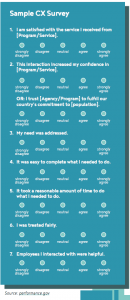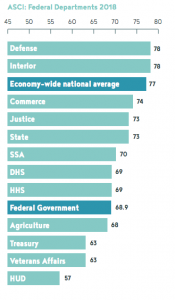This article is an excerpt from GovLoop’s guide, “Government’s Customer Experience Playbook.” Download the full guide here.
Federal agencies have been measuring customer satisfaction since at least 1993, when President Bill Clinton issued an executive order focused on that and setting customer service standards. However, “benchmarking results across agencies has not been possible because each agency has used its own instrument,” according to the Office of Personnel Management. Here’s what’s different now:
CX in the President’s Management Agenda:
As part of the PMA and associated Cross-Agency Priority goals, federal agencies are zeroing in on improving CX with federal services. The overarching objective is to “provide a modern, streamlined, and responsive customer experience across government, comparable to leading private-sector organizations,” and the administration has laid out a roadmap with milestones and status updates at Performance.gov. The team leading the governmentwide CX efforts is also evaluating “inclusion of customer experience measures in appropriate executive performance plans or agency performance goals.”
Measuring CX:
Agencies are tasked with identifying their highest-impact customer journeys — using customer volume, annual program cost and/or knowledge of customer priority as weighting factors — and selecting touchpoints or transactions within those journeys to collect feedback. The Trump administration is also focused on creating publicly available CX performance dashboards that show how government agencies are performing in key areas, such as overall customer satisfaction, quality and employee helpfulness.
Uptick in mobile users:
The rise of mobile users and how to best serve them should be a priority for agencies, if it isn’t already. Citing the U.S. Digital Analytics Program, Jacob Parcell, Acting Director of GSA’s Innovation Portfolio, said that 2019 is the first year that more than 50 percent of sessions on government websites were mobile users. Government websites on average now handle more than 20 million users daily, he added, with about 48 percent of traffic on federal websites coming from mobile devices.
Legislation elevates digital experience:
In terms of legislation, lawmakers have made a strong tie between the role technology plays in CX through the passage of 21st Century IDEA. President Trump signed it into law December 2018, and it set requirements for federal website modernization and digitization of government forms and encourages acceleration of electronic signatures.

OMB’s CX guidance & updates:
In addition to the PMA, federal agencies are implementing first-of-its-kind CX guidance from the Office of Management and Budget (OMB). The goal is to “institutionalize the fundamental building blocks of CX across federal high-impact service providers,” such as the Internal Revenue Service, Centers for Medicare and Medicaid Services, and Citizenship and Immigration Services.
These high-impact service providers operate the government’s most critical digital services on which millions of people depend. The expectation is that they will serve as examples for other agencies.
OMB’s CX guidance attempts to categorize the types of government services and agencies, such as the Transportation Security Administration and the Occupational Safety and Health Administration, which are not typically viewed as CX organizations but rather more compliance-based.
The governmentwide team focused on elevating CX, which includes representation from OMB, is also working with agencies to standardize clearance or approval templates to conduct CX-related activities, which are subject to Paperwork Reduction Act requirements. The 1980s law was designed to reduce the total amount of paperwork burden the federal government imposes on private businesses and citizens through activities such as qualitative customer research, gathering customer feedback data, and conducting service and digital product testing. The standards are expected to ease the burden on conducting those activities.
American Customer Satisfaction Index (ACSI) Federal Government Report 2018:

The American Customer Satisfaction Index (ACSI) federal government model includes four key drivers of citizen satisfaction: the quality of information, customer service, timeliness and ease of government processes, and usefulness of government websites. ACSI results are reported on a scale of 0 to 100. Satisfaction with federal services fell 1.1 percent in 2018 to 68.9 but remains at its second highest level since 2008. The survey was conducted before the 35-day government shutdown, so any impact from that will show up in the 2019 survey.





Leave a Reply
You must be logged in to post a comment.